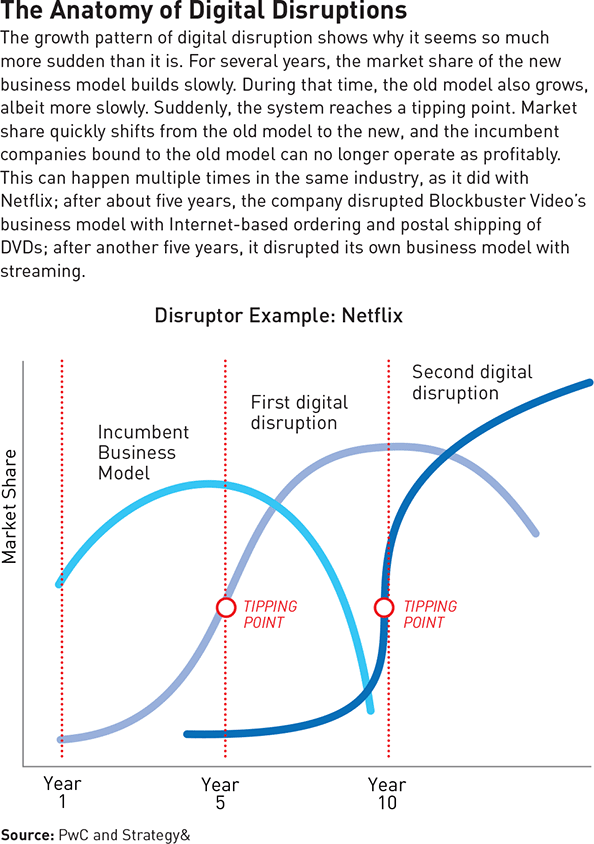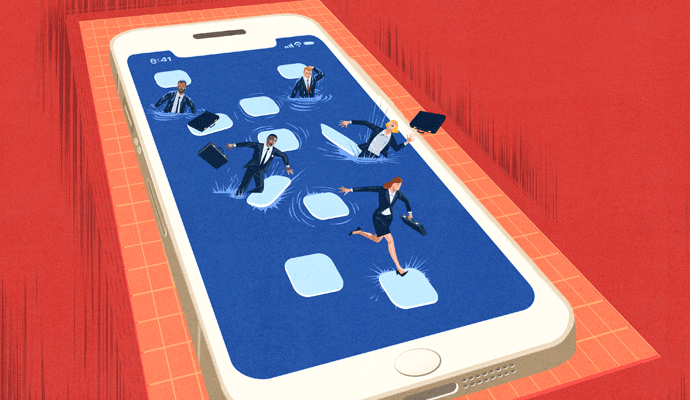The Coming Wave of Digital Disruption
Technological changes foreshadow a dramatic — but manageable — shift in business logic everywhere.
A version of this article appeared in the Spring 2018 issue of strategy+business.
For the past 30 years, business has changed dramatically because of digital innovation — but only up to a point. Although many practices, products, and services have evolved, and a few sectors (such as media) have been fundamentally changed, very few enterprises have had their core businesses disrupted. But that is about to change, in a way that will — or should — affect the strategy of your company.
All disruption (digital or otherwise) takes place on an industry-wide scale, forcing a significant shift in profitability from one prevailing business model to another. The new model typically provides customers with the same or better value at a much lower cost. Companies wedded to the old business model lose ground, and some are pushed out of business. Challengers that embrace the new business model gain advantage and take a dominant position in the market. The winners may be new entrants, such as Southwest Airlines in the 1980s, Google in the 1990s, and Netflix and Facebook more recently. They could also migrate from another sector, as Apple did when it moved from computer to mobile media and as Amazon did with groceries. Or they could be large incumbent companies shifting business models, as GE is attempting now with its large-scale business-to-business offerings (for example, its integrated industrial Internet platform, Predix).
Businesspeople have been worried about disruption at least since at least 1997, when Clayton M. Christensen popularized the word in his book The Innovator’s Dilemma: When New Technologies Cause Great Firms to Fail. But the degree of actual disruption in business over the past 15 years is much lower than you might expect. Our colleagues at PwC discovered that discrepancy in a research project published this year, in which they tracked the top 10 companies (by revenue) in 39 key sectors. On average, only 6 percent of company value shifted over a full 10-year period, except for the three most volatile sectors (Internet software and services, IT, and biotechnology). Even there, the figure was only 10 percent. In short, if you measure disruption by the market share gain or loss in the dominant companies in each sector, most industries have not yet been affected.
The current wave of disruption is different. Today's digital technologies involve unprecedented breadth and scale — comparable to the introduction of commercial electric power in the early 20th century. Digital disruption is a change in industry value triggered by advances in information and communications technology. (By this definition, the shift to electric cars is not digital disruption, because it is largely enabled by advances in battery technology, but a move to autonomous vehicles, made possible by digital networks, is.) During the next few years, the technologies associated with this wave — including artificial intelligence, cloud computing, online interface design, the Internet of Things, Industry 4.0, cyberwarfare, robotics, and data analytics — will advance and amplify one another’s impact. Products and processes will routinely learn from their surroundings; markets will converge to an unprecedented extent. As electric power did, the new wave of technological advance is expected to alter a wide array of business practices, in nearly every sector, and in both business-to-business and business-to-consumer firms.
Although the pace of disruption can be slower than people expect, the time to act is now — for three reasons. First, preparations for these changes require time. As when a hurricane is bearing down on a coastline, the longer you wait to act, the more vulnerable you become. The precise tipping point will vary from one industry to the next, but some common threads will emerge. Prices will decrease, assets will lose value, and the willingness of customers to change their habits will determine the pace of change. This is happening to some old-model retailers now; their businesses may not be formally bankrupt, but the dollars they invest in their legacy businesses don’t earn a return. So they cut back their spending, and their stores deteriorate further.
Second, even during the earliest stages, before they reach that tipping point and lose their industry position, the incumbents tied to old business models often see their growth level off or decline. Old-model retail store chains, for example, have felt the impact on their shareholder value years before they approach bankruptcy. That’s why you have to let your constituents, particularly your investors, know that you are preparing to face major changes. The most effective activist investors, as our colleagues Mathias Herzog, Tom Puthiyamadam, and Nils Naujok have noted, are already aware of which companies are well positioned for digital disruption. Those that aren’t clearly making such preparations tend to become targets.
Third, remember that, although the pace of change can be glacial, the glaciers cannot be avoided. Disruption will, eventually, reach its destination. This was the essence of Christensen’s original argument: that the disruptive innovation is at first applied to a small, unattractive niche, and it seems easy to ignore. Gradually it matures, improves in quality and capability, and then switches over to the mainstream. In the early stages of its advance, it will seem to many people as though nothing is happening. By the time the shift is felt, it will seem sudden. But if you’ve started early to prepare, you’ll be ready for it.
The future of your enterprise will depend on how well you understand these dynamics in your industry and in general. Focus on strategic changes that reflect and incorporate your own existing strengths, as opposed to those that may impress investors in the short run but not add to your sustained performance. For example, some retailers try to ramp up their digital prowess rapidly by outsourcing functions such as same-day delivery. This gives investors the impression they are proactive; but in the long run, the addition may not be profitable unless it gives the company a sustained advantage tied to its own innovation.
Assessing the Impact
You may be skeptical about the impact of digital disruption in your industry, especially if other forms of disruption seem more imminent. For example, the oil and gas industry has been upended more by hydraulic fracturing (fracking), a non-digital technology that has greatly increased supply, than by digital technology, which has been most manifest in oil field–style sensors and operational controls. Though the automotive industry is framing its future in terms of self-driving vehicles, battery technology will probably represent just as great a change; it could determine how quickly automakers abandon the internal combustion engine. Some of the great past cases of disruption — for example, the way point-to-point airlines such as Southwest and Ryanair disrupted the hub-and-spoke model of their industry, or the way mini-mill steel companies threatened the steel giants — didn’t involve digital technology at all. Other non-digital disruptions, such as personalized medicine in life sciences or nanotechnology in chemicals, will continue to have dramatic effects on their industries.
Although the pace of disruption can be slower than people expect, the time to act is now.
But digital disruptions are different in several critical ways. They involve technologies that can reduce the need for physical assets; for example, streaming media took the place of compact discs, and algorithms that specify traffic routes for shared-vehicle enterprises can raise the efficiency of passenger travel and thus reduce the number of cars and vans needed in an area. Digital systems accumulate data and, through machine learning, continually improve the performance of the new business models, thereby accelerating their impact. Digital disruptions reshape value chains and markets, rendering the old differences among sectors irrelevant; now a single home device can be a music player, a thermostat, a security system, and a retail portal. They affect a broad number of sectors, and they encourage companies to add scale by creating platforms that make it cheaper to enter new geographies or launch new products and services. Another effect is the increased demand in a broad range of industries for people with software skills (which are more fungible than other forms of engineering prowess) and a Silicon Valley sensibility. It’s safe to say that no one from inside the aerospace and defense industry of the 1980s would have developed the remote-controlled military vehicles and drones emerging today, piloted from far away as if they were video games. Only people from the computer industry could accomplish that.
To respond effectively to this type of disruption, a company must also reinvent itself, moving from one business model to another. For example, one company, Netflix, has triumphed through two successive episodes of digital disruption. In both cases, as the technology advanced, the company was ready with a new business model that met customer needs more effectively at a lower cost (see “The Anatomy of Digital Disruptions”).

When Reed Hastings founded Netflix, in 1997, it competed against Blockbuster Video, a brick-and-mortar retailer that led the video rentals market in the United States, with a large chain of neighborhood stores. By sending its DVDs out by mail and not requiring return by a specified date, Netflix reduced consumer costs and eliminated a major source of irritation — and significantly reduced Blockbuster’s advantage. Its business model, which substituted a monthly subscription fee for individual rental fees, added to its customer appeal. So did its initial foray into Amazon-style customer data gathering; based on the types of movies customers rented, Netflix would recommend others that would probably appeal to them.
At first, Blockbuster seemed immune to the threat; it lost only a small percentage of its overall revenues to Netflix’s disruption. But because of the fixed costs of brick-and-mortar stores, those revenue losses ate into store-by-store profitability. Before the disruption, nearly all of the Blockbuster stores covered the cost of capital with profits. After disruption, only about half of them could do so.
In the second episode, which began in 2007, Netflix disrupted its own business (and killed the rest of Blockbuster’s) by introducing streaming video on demand. Blockbuster responded by introducing new revenue sources (such as selling popcorn and candy), but it continued to decline, filed for bankruptcy in 2010, and never recovered. Within a few years, the vast majority of Netflix’s consumers had shifted to streaming. The company was now competing not just with DVD rentals, but with cable television, which adapted with video-on-demand services of its own. Moreover, Netflix continually refined its analytic capabilities, offering more fine-grained recommendations, which consumers could explore more quickly with the flexibility of streaming. This analytic capability fed naturally into the creation of original content, which began with House of Cards in 2013 and has expanded to more than 350 original series released in 2017.
It’s worth noting that Hastings, who had been a software entrepreneur in the early 1990s (with Pure Software), foresaw streaming almost from the start. He knew that computing and telecommunications capacity was not ready for movies on demand via the Internet, but that would be soon. The subscription model, at the core of his first disruption, was intended not just to compete in the short run, but to position his company to offer streaming when the technology caught up. A quote from a 2005 interview with Inc. magazine shows how clear Hastings's foresight was: “DVDs will continue to generate big profits in the near future. Netflix has at least another decade of dominance ahead of it. But movies over the Internet are coming, and at some point it will become big business. We started investing 1% to 2% of revenue every year in downloading, and I think it's tremendously exciting because it will fundamentally lower our mailing costs. We want to be ready when video-on-demand happens. That's why the company is called Netflix, not DVD-by-Mail.”
Hastings also intended, from the start, to get into content production, again because he saw the business value. “Our focus,” he told Inc., is on “becoming a company like HBO that transforms the entertainment industry.” The lesson for other companies is that a precise view of digital disruption in your industry can clarify your strategy by showing you not only the challenges demanding your response, but the opportunities that others don’t yet see.
In both episodes, Netflix rode the wave of disruption, taking advantage of three factors that accelerated the change. These factors can provide similarly powerful opportunities in your own industry:
1. Significantly lower cost. Nearly every major disruption lowers prices dramatically — often in ways that startle conventional industry observers. The personal computer is a classic example; it brought to a desktop computer power that had previously cost hundreds of thousands of dollars. There is always a market for the same or a better offering at a lower price, and only sometimes a market for a better offering at a premium price. Moreover, even disruptions that seem more expensive at first glance, such as the iPhone, often turn out to offer cost benefits. For many of its users, the iPhone eliminated the need to buy landline phones, music players, cameras, calculators, portable organizers, electronic calendars, alarm clocks, televisions, and (for many owners) computers. The phone incorporated and regularly upgraded all these functions without any additional cost.
There is always a market for a better offering at a lower price, and only sometimes a market for a better offering at a premium price.
Truly disruptive companies don’t just lower prices on a case-by-case basis. They maintain a reputation for what Walmart calls “everyday low prices”: such consistent cost savings that they don’t have to be monitored. Customers become deeply loyal if they feel they can trust a company’s low-price commitment; if the company loses their trust by letting prices drift upward, it will lose its value proposition. Amazon has on occasion cut prices on goods from third-party sellers, while still paying them the same amount per item, to keep its value-price reputation intact.
Lowering prices usually requires lowering operational costs. As Strategy& thought leaders Bertrand Shelton, Thomas Hansson, and Nick Hodson put it in “Format Invasions,” a seminal s+b article of the mid-2000s: “Massively lower cost is the killer app in many markets — as companies as diverse as Dell, Inditex (Zara) apparel, Countrywide Financial, Nucor, Walmart, and Charles Schwab, as well as Toyota and Southwest Airlines, have shown. Toyota’s lean manufacturing methods, which ruthlessly eliminated the waste in its production systems, led to costs far below those of the Big Three Detroit automakers. Southwest’s point-to-point format for air travel vastly reduced the ground and flight costs inherent in the ‘hub-and-spoke’ format of the airline industry’s established leaders.”
Digital technology enables price cuts because, when applied strategically and innovatively, it reduces operational costs in a continuous way. For example, 3D printing has cut prototyping costs considerably in R&D, and appears likely to do the same for inventory costs related to storing components.
2. A more effective approach to customer demand. Disruptive business models generally find a new approach to meeting customer demand, one that adds convenience or provides value. Amazon supplanted other online retailers not just through lower prices, but by combining them with a significantly more convenient and engaging interface. Because most people are reluctant to change their habits, a true disruption will often take a fairly long time, even after early adopters express their enthusiasm. The new system must be not just desired, but trusted.
For example, the automated teller machine, introduced in 1967, became commonplace in the 1980s. Even at that early stage, it was clear it would be a disruptive digital technology, providing unprecedented convenience and giving people access to their cash and accounts they had never had before. But it wasn’t until the mid-1990s that the ATM was accepted by most bank customers. Before that, many people preferred live tellers; they weren’t sure their deposits would be properly credited. There is a similar delay today with the adoption of cloud computing. Many companies still rely on their on-premises data centers, in part because some critical features, such as cybersecurity, are considered to be still evolving.
3. Better use of assets. Digital technology allows companies to do more with assets that were underutilized before, or to find opportunities that others didn’t see. This drives scale, and scale drives profitability. For example, companies like Zipcar offer temporary cars with much less friction than conventional car rental companies, because they can locate cars and track their usage far more easily. Similarly, cloud computing represents a more efficient use of networked processor time than on-premises storage. Another asset is employee time, which can be used more productively with flexible hours, job-sharing arrangements, and remote-work opportunities — which are easier to arrange en masse with digital tracking. Ride-sharing services combine several underused assets, including the cars, the drivers’ skill, and the time that drivers would otherwise spend seeking fares and managing billing procedures.
Making better use of assets may require new approaches to regulations and governance structures that incumbent companies have internalized, and that affect how they operate. For instance, ride-sharing services entered many cities by finding a model that navigated among medallion-based taxi companies, which are typically highly regulated; car services, which are less restricted; and privately owned vehicles, which are underutilized. Regulations are often designed to protect established assets (in this case, taxi medallions and permits); finding permissible ways to circumvent them gives the new disruptive business model a chance to grow. By the time the regulators have caught up to it, as with ride-sharing services, the disruptive model is often too popular to supplant.
The reliance on assets also helps explain why some companies hold on for so long to their old business model. For example, consider those retail chains that are overinvested in real estate locations for their brick-and-mortar stores, which no longer return the investment required to keep them up to date. It takes time to sell them at a profit. In the meantime, as long as the assets must be maintained, the retail chain will be under pressure to lower those maintenance costs, even if it means the quality of the customer experience suffers. When a struggling retail chain can’t close unprofitable stores, those outlets visibly deteriorate, which drives customers away from the brand.
Netflix created value with all three drivers of digital disruption. It lowered cost, especially when factoring in the cost of Blockbuster’s late fees. Through its fluency in analytics, it found new ways to attract consumer demand. Its streaming made use of personal computers, tablets, smartphones, and Internet infrastructure, all assets that consumers had already paid for. Moreover, because the Netflix model was based on the Internet, it bypassed regulations that covered broadcast and cable TV.
After the Tipping Point
As the disruptive companies deliver improved value in all these ways, customers come on board. Old customer habits erode slowly. Old relationships and an installed base of products and services are still attuned to the old approach. But eventually, a tipping point is reached, as revenues and purchases move to the new model and rapidly gain momentum. Customers see how easy and beneficial it will be for them to switch to, say, streaming, or using their smartphone as a camera. At that point, the remaining majority of people shift suddenly, and so does the industry. From there, it may take just months until the old business models are no longer sustainable.
Once the tipping point is reached, even a small shift in market share can be deadly to the old business model. For example, when a fraction of a retail store chain’s volume migrates online, it can lead to a disproportionate drop in profitability, because the fixed costs of the brick-and-mortar store (including the overhead spent by headquarters on personnel and store support) remain. Making up that loss will be impossible for many companies, and for others, it will require drastic measures. That’s why Walmart bought the discount store Jet.com in 2016, after waiting so many years to change its business model. Its leaders perceived that the disruption could no longer be ignored.
The disruption typically takes one of two forms. In some cases, the new model almost completely replaces the old. Examples include the pre-recorded audio tape, typewriter, and film photography industries. This wholesale shift of value represents an existential threat to the incumbents. Few of them may survive.
But most disruptions are partial; the new and old business models coexist, dividing the market between them. The overall profit pools are large enough to sustain both business models, albeit sometimes in new forms. Some legacy companies adapt modestly to the new world and find ways to keep attracting new customers. For example, online grocers have not replaced neighborhood supermarkets — and probably won’t, in part because of the high costs of delivering fresh food and ensuring its quality. But online supermarkets are forcing older food retail companies to adjust by adding prepared entrees, fresh local offerings, and curbside pickup arrangements.
Many partial disruptions could continue perpetually. Hotels will probably coexist with home-sharing services for a long time to come. In other cases, a business model disruption might start as partial disruption and end up moving into total or near-total disruption, as with the smartphone virtually replacing the digital camera. In either case, the appropriate response is not to panic. Rather, it is to look for ways in which you might disrupt your own business, and your industry, using the strengths that made you great in the first place, and that continue to define you.
This wave of digital disruption will have far-reaching effects. Already, digital technology has shown its ability to outpace or outmaneuver efforts to control it. And the technology sector has shown its willingness to borrow from many different kinds of enterprises in the name of helping companies compete. Finally, with the emergence of global-scale platforms — China’s Belt and Road Initiatve, Europe’s Industry 4.0 platform, and the cloud-based systems of Amazon, Google, and Microsoft among them — it will be easier and easier for other sectors to create dynamic, disruptive new business models. The constraint for your company will not be the technology. It will be your ability to bring the three drivers to bear: to lower costs, engage customers, and make better use of assets. If you can employ digital technology to do that effectively, you will be among the winners of the age of digital disruption.
Author profiles:
- Leslie H. Moeller is a former principal at PwC US and the former global head of Strategy&, PwC’s strategy consulting business.
- Nicholas Hodson is a thought leader with Strategy& based in San Francisco. He is a principal with PwC US and specializes in strategic transformation, performance improvement, and digital strategies for retailers.
- Martina Sangin is a thought leader with Strategy& and director of global platforms for PwC US. She is based in Chicago.
- Also contributing to this article were PwC Germany partner Nils Naujok; PwC US principals Mathias Herzog, Tom Puthiyamadam, and Paul Leinwand; former PwC US managing director Bertrand Shelton; and PwC US senior manager Miriam Ready.




